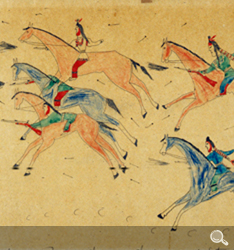

History can be kept and revealed in many ways. In the late 19th century, Native men from the northern and southern plains developed a style of visual history by fusing older, symbolic paintings on hide with new representational stories drawn on paper. These drawings presented and preserved the men’s personal and tribal memories, at a time when their ways of life were threatened with extinction.
Like many of the world’s peoples, American Indians kept history in dances, songs, and stories, and in a highly symbolic form of picture writing, called “pictographs” by Anglo-Europeans. To the people who were making and sharing them, these new drawings were historical documents—personal, political, cultural, and social.
Many Americans know and appreciate the representations of Native peoples as made by 19th-century painters and photographers. The drawings in this exhibit give a first-person version of American Indian history, as the artists lived it.
This drawing of U.S. Army cavalry soldiers, in a charge, displays the uniformity of the colors, equipment, and methods of the military. The soldiers fire their rifles at the Sioux and Cheyenne targets ahead of them. Some of these drawings are so accurate that the specific unit uniforms and types of firearms can be identified.
The Cheyenne Indians pictured in this drawing are displayed in identifiable Warrior Society clothing. The warriors ride at a gallop, the hoof marks indicating movement, while firing their rifles at the U.S. troops. Two riders lean low behind the necks of their trained war horses shielding themselves from the bullets which fly in all directions.
Explore this exhibition:
1 of 6

